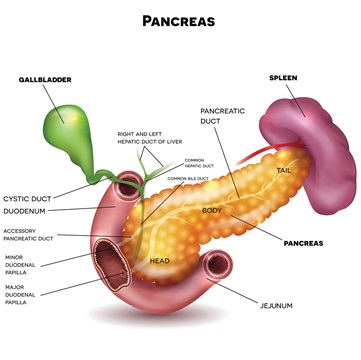The Pancreas – Medical Science Notes – For W.B.C.S. Examination.
The pancreas consists of two kinds of tissues: endocrine and exocrine. The latter produces pancreatic juice, a combination of digestive enzymes that empty via a duct into the small intestine.Continue Reading The Pancreas – Medical Science Notes – For W.B.C.S. Examination.
The endocrine tissue of the pancreas—the islets of Langerhans—secrete the hormones insulin and glucagon into the bloodstream. These hormones are vital to the regulation of carbohydrate metabolism and exert wide-ranging effects on the growth and maintenance of body tissues. Insufficient insulin production results in type 1 diabetes mellitus, a disease that is fatal without daily injections of insulin. Even with insulin therapy, many diabetics suffer kidney failure and blindness due to the disease’s effects on the small blood vessels. A pancreas transplant can potentially prevent the progression of these complications.
Much effort has been devoted to removing the islets of Langerhans from the pancreas with a view to grafting the separated islets or even the isolated insulin-producing beta cells. Unfortunately, it is very difficult to obtain sufficient islets from the fibrotic human pancreas, and it appears that isolated islets are highly susceptible to rejection. A number of clinical attempts at islet grafting have been made.
Transplanting the vascularized pancreas has been more encouraging. It is customary to graft the body and tail of the pancreas; that is, half the pancreas is transplanted, using the splenic artery and vein for vascular anastomosis. One of the difficulties with this procedure has been dealing with the digestive juice produced by the transplanted pancreas. A further complicating factor has been the fact that corticosteroids—frequently used for immunosuppression in transplant patients—aggravate diabetes. The availability of cyclosporine permitted the avoidance of corticosteroids. Later, triple-drug immunosuppression, using cyclosporine, tacrolimus, and mycophenolate mofetil, was introduced.
Pancreas transplantation is particularly attractive when a patient with diabetic kidney failure can receive a kidney and pancreas graft from the same donor. A technique with encouraging early results has been to insert the pancreas graft very close to the patient’s own pancreas in the so-called paratopic position.
This allows drainage of insulin directly into the liver, while the pancreatic juice is diverted into the stomach, where the digestive enzymes are inhibited by stomach acid. It is certainly most gratifying to patients who have been undergoing regular dialysis and taking insulin to be free from both these onerous treatments and to be permitted to eat and drink without restriction. The five-year functional survival rate for pancreas transplant is about 90 percent. It is of interest that the vascularized pancreas probably is less susceptible to rejection than the kidney.
Please subscribe here to get all future updates on this post/page/category/website


 Toll Free 1800 572 9282
Toll Free 1800 572 9282  mailus@wbcsmadeeasy.in
mailus@wbcsmadeeasy.in



















































































































